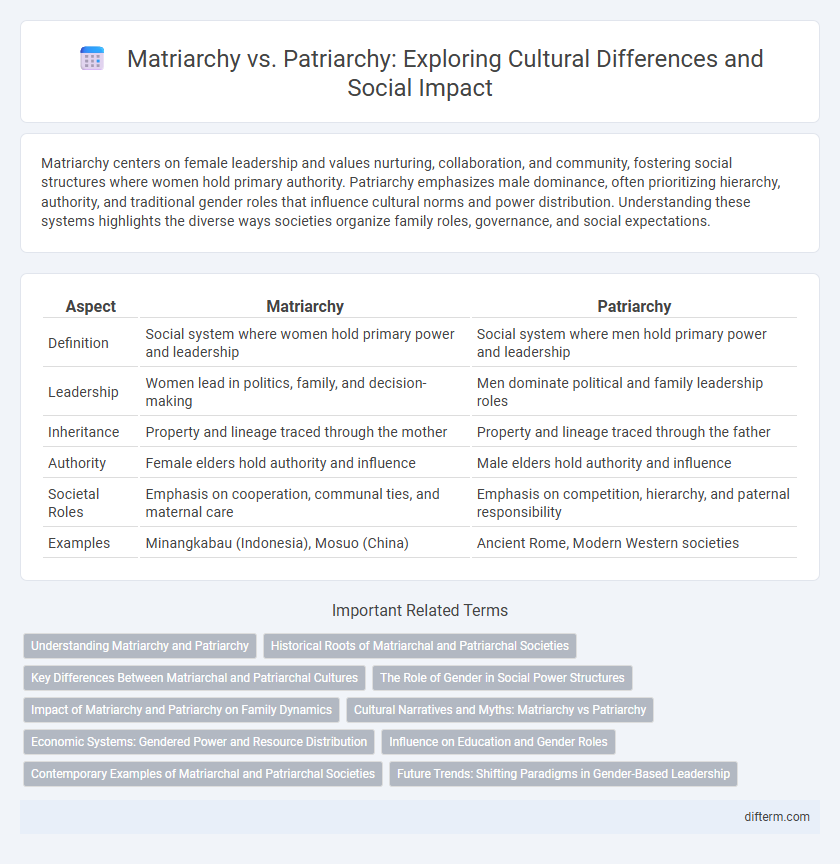Matriarchy centers on female leadership and values nurturing, collaboration, and community, fostering social structures where women hold primary authority. Patriarchy emphasizes male dominance, often prioritizing hierarchy, authority, and traditional gender roles that influence cultural norms and power distribution. Understanding these systems highlights the diverse ways societies organize family roles, governance, and social expectations.
Table of Comparison
| Aspect | Matriarchy | Patriarchy |
|---|---|---|
| Definition | Social system where women hold primary power and leadership | Social system where men hold primary power and leadership |
| Leadership | Women lead in politics, family, and decision-making | Men dominate political and family leadership roles |
| Inheritance | Property and lineage traced through the mother | Property and lineage traced through the father |
| Authority | Female elders hold authority and influence | Male elders hold authority and influence |
| Societal Roles | Emphasis on cooperation, communal ties, and maternal care | Emphasis on competition, hierarchy, and paternal responsibility |
| Examples | Minangkabau (Indonesia), Mosuo (China) | Ancient Rome, Modern Western societies |
Understanding Matriarchy and Patriarchy
Matriarchy and patriarchy are social systems that define the distribution of power based on gender roles, with matriarchy centered on female leadership and patriarchy emphasizing male dominance. Anthropological studies reveal that matriarchal societies often prioritize communal decision-making and maternal lineage, while patriarchal cultures typically focus on hierarchical authority and paternal inheritance. Understanding these frameworks is critical for analyzing cultural dynamics, gender relations, and historical social organization across various civilizations.
Historical Roots of Matriarchal and Patriarchal Societies
Matriarchal societies, often rooted in prehistoric times, emphasized lineage through the female line, with examples found among the Iroquois and Minangkabau peoples, where women held significant social and economic power. Patriarchal structures solidified with the rise of agricultural civilizations and codified laws, exemplified in Ancient Mesopotamia and Classical Greece, where male dominance shaped political and familial hierarchies. These historical roots reveal how gendered power dynamics evolved from subsistence and kinship systems to institutionalized governance and inheritance patterns.
Key Differences Between Matriarchal and Patriarchal Cultures
Matriarchal cultures prioritize maternal lineage, valuing female authority and inheritance while often emphasizing communal decision-making and nurturing roles. Patriarchal cultures emphasize paternal lineage, with male authority dominating social, political, and economic structures, frequently reinforcing hierarchical and individualistic values. These systems influence gender roles, power distribution, and societal organization, shaping distinct cultural norms and familial relationships.
The Role of Gender in Social Power Structures
Matriarchy and patriarchy represent contrasting gender-based social power structures where authority and leadership are predominantly held by women and men, respectively. In matriarchal societies, lineage and inheritance often follow the female line, influencing social organization, decision-making, and cultural values. Patriarchal systems concentrate power and privilege in men, shaping legal frameworks, economic roles, and social hierarchies that impact gender relations and societal norms.
Impact of Matriarchy and Patriarchy on Family Dynamics
Matriarchy often fosters cooperative family dynamics by emphasizing communal decision-making and nurturing roles, leading to stronger emotional bonds and shared responsibilities. In contrast, patriarchy typically centers on hierarchical structures with dominant male authority, which can result in rigid gender roles and limited emotional expression within families. These differing frameworks significantly influence communication patterns, caregiving approaches, and power distribution in familial relationships.
Cultural Narratives and Myths: Matriarchy vs Patriarchy
Cultural narratives and myths often shape perceptions of matriarchy and patriarchy by embedding gender roles within foundational stories and societal values. Patriarchal myths, prevalent in many cultures, typically glorify male dominance and heroic masculinity, reinforcing power hierarchies and inheritance through the male line. Conversely, matriarchal narratives emphasize female authority, nurturing qualities, and communal leadership, highlighting cycles of fertility and earth-based spirituality as central to societal organization.
Economic Systems: Gendered Power and Resource Distribution
Economic systems within matriarchal societies often emphasize communal ownership and equitable resource distribution, reinforcing female-centric power dynamics. In contrast, patriarchal economies typically concentrate wealth and decision-making authority in male hands, perpetuating gendered disparities. These divergent structures significantly influence access to resources, labor division, and overall societal hierarchy.
Influence on Education and Gender Roles
Matriarchy and patriarchy distinctly shape education and gender roles through cultural norms and power dynamics. In matriarchal societies, educational content often emphasizes communal values and gender equality, fostering inclusive learning environments that challenge traditional gender roles. Patriarchal systems typically reinforce male dominance by promoting gender-specific curricula and social expectations, limiting opportunities for women and perpetuating stereotypical roles in both education and society.
Contemporary Examples of Matriarchal and Patriarchal Societies
Contemporary matriarchal societies such as the Mosuo in China emphasize female-led family structures and communal decision-making, contrasting with patriarchal societies like Saudi Arabia, where male authority dominates legal and social frameworks. In the Mosuo, inheritance and lineage are traced through women, reinforcing maternal influence in cultural and economic life. Conversely, patriarchal systems typically vest leadership and property rights with men, shaping gender roles and societal hierarchies around male dominance.
Future Trends: Shifting Paradigms in Gender-Based Leadership
Emerging research indicates a gradual shift toward more inclusive gender-based leadership models, blending elements of both matriarchy and patriarchy to foster equitable decision-making. Organizations and societies increasingly value collaborative leadership styles traditionally associated with matriarchal systems, such as empathy and community orientation, while retaining structural aspects of patriarchal hierarchies for stability. Technological advancements and global connectivity accelerate this transformation, enabling diverse voices to influence cultural norms and redefine power dynamics for future generations.
matriarchy vs patriarchy Infographic

 difterm.com
difterm.com